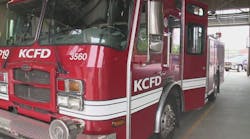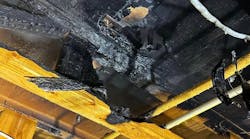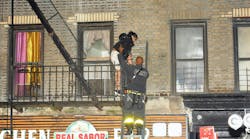After three years of investigations conducted under the National Construction Safety Team Act, last year at a Congressional Hearing, National Institute of Standard and Technology (NIST) released their final report of the World Trade Center (WTC) collapse investigation. As emergency responders first on the scene to all types of emergencies, it is of utmost importance that we recognize that the NIST's WTC recommendations have direct relevance to all of us.
A quick glance at the NIST's WTC report reveals that even though these recommendations came in the aftermath of a horrific terrorist event, none of these recommendations are solely based on terrorist threats, and they have multi-hazard response applications. The enhancements recommended by NIST, have a direct impact on protecting both the building occupants and our firefighters, from all types of incidents that require full building evacuation and interior emergency operations.
It is important to recognize that the NIST's WTC recommendations are not futuristic and were developed based on the available technologies and the standard operating procedures and capabilities of the fire service in responding to the high-rise emergencies. These recommendations are focused on increasing the structural integrity of the buildings to avoid progressive collapse and total structural failure; enhancing the fire resistance of the structures protecting the structural members by installation of better and additional layers of fire resistance and spray-on fire resistance materials; requiring active fire protection systems; enhancing tenability and providing fire safety for the building occupants; improving the means of egress by increasing the stairwell capacity and stair discharge door width to accommodate counter-flow due to access by emergency responders; improving elevator and hoist-way design to allow usage of elevators both in evacuation and also in firefighters' staging operations; and improving communication technologies and procedures for the emergency responders by installation of radio amplification systems, etc.
These recommendations have direct relevance to us, and apply to our operations in mitigating any types of hazards in the high-rise buildings. We face the same types of challenges in responding to any emergencies in high-rise buildings. High-rise evacuation, for example, is quite problematic, because whether it is fire, explosion or other kinds of acts of terrorism, or even a hoax threat of terrorist attack, they would all result in the full occupant evacuation which would cause counter-flow problems for the responding firefighters.
The recommendations in NIST's WTC report, have something in common, time. Structural improvements and passive fire resistive enhancements provide for additional time prior to structural failure. Active fire protection systems provide additional time for the occupants before the tenability is compromised. Means of egress enhancements decreases the time to evacuate the building, and by reducing counter-flow problems it also decreases our time to stage our interior operations. And similarly modifications to the elevators would also save us time in getting our firefighters and equipment to the staging floor. Enhancements to the fire communication systems provide us real time information for all our fire command and control purposes.
The gist of our fire suppression and all our other emergency responses is simply one thing, time. From the very moment that we receive the dispatch, our performance is measured in time, and our fight is simply against time. In the fire service we have known for a long time that delayed response time could have direct adverse impact on the outcome of the call. The fact of the matter is though that time is actually what we don't have as a luxury, when responding to the high-rise emergencies.
In high-rise buildings, full building evacuation takes a long time, and so does getting the firefighters and equipment to the staging floor. In other grade level structures, we normally have more time to assemble an adequate level of equipment and personnel to be able to mitigate the hazard, than we have in a high-rise. We also have a better real time damage assessment in those occupancies than in a high-rise.
When responding to a high-rise, the exact extent of damage is not fully known, until the time that we actually ascend to the floor of origin. In an attempt to save lives, in a high-rise, we feel obligated to start our ascension with very limited knowledge about the extent of damage or the structural integrity of the building. And as history has proven, we might not even have enough time for an "ALL CLEAR" call.
As a rule, in the fire service "we risk a lot to save a lot, and risk a little to save a little". But, in a high-rise emergency, even though the occupants might have all been evacuated, we still perform the interior firefighting operations, simply because the possibility of structural burnout and collapse is very real, and such failure could pose a hazard to several city blocks in the collapse zone. Let's face it, in a high-rise building, we don't have much of an option but to go interior; and we can't immediately take the defensive strategy of hazard containment by staying out and staging at the parameters.
Our ladder trucks can reach only to certain heights, and our fire engines can pump water to only a limited number of floors. Reality of it is that in a high-rise building, not only the building occupant, but also our own firefighters rely solely on the appropriate performance of the building's built-in passive and active fire protection systems. Let's face it, as firefighters we are at the mercy of the architects and engineers designing these high-rise buildings. Bottom line is we are simply relying on the strength of the building codes under which these structures were constructed.
The criteria for the design professionals designing these buildings though are not necessarily identical to the fire service's needs and perspectives. To them "cost" plays a major role in their designs and the level of built-in fire protection they provide in the high-rise buildings.
Besides the building officials and the fire marshals participating in the development of the construction codes, building owners, manufacturers, engineers, architects, etc, also play a major role in the development of the building codes. And their influence is quite heavy, and their interests at times oppose the fire service's interests. Our plight to have the adequate time to have a fighting chance in these high-rise buildings translates to increased construction cost to the developers and the building owners.
The cost associated with implementing the NIST's WTC recommendations into the building codes has put the interests of the owners and their design professionals, in opposition to ours. They believe that the cost impact of implementing those recommendations into the building codes is too prohibitive. They say that based on the historical fire safety records of the high-rise buildings, and also the fact that the majority of our fire losses and firefighter fatalities occurred in the other types of occupancies and structures than the high-rises; then there is not enough justification to implement the NIST's WTC recommendations.
To justify their position, they claim that the high-rise buildings could not be designed to take the impact of an airplane, as it was the case in the September 11, 2001, terrorist attacks. And their general stance is that to make any changes in the building codes, scientific data must be presented and "probabilistic analysis" must be performed, proving the need for implementation of the NIST's WTC recommendations.
The opposition's views are indeed different from our perspective. Even though there is some merit to their logic, their statistics are based solely on the fire statistics. Yet, they fail to acknowledge that fire is not the only hazard that fire service responds to in a high-rise building. Fact is acts of terrorism are not limited to a plane flying into a building. And in reality, whether it is a bio-chemical release or a suicide explosion by a terrorist, full building evacuation is inevitable and the building occupants themselves would disregard any "shelter in place" orders anymore. In such instances, our response would still be delayed by the counter-flow problems.
Where the opposition argues about the cost, we seek adequate time to evacuate the building and perform our interior operations to mitigate the hazard. No, fire service is not naive and inconsiderate to the cost issues imposed by implementing the NIST's WTC recommendations. We in the fire service should, and indeed must work with the design professionals, to reach cost effective solutions in providing enhanced levels of fire protection and life safety for the building occupants and our own firefighters. But, I find the opponent's general disregard for our firefighters' safety rather appalling and their unwillingness to consider any fire and life safety enhancements quite irresponsible. We just don't want our own brothers and sisters, in addition to the occupants of these high-rise buildings, to pay the ultimate price as they did back in September 11, 2001.
The opponents might not recognize it, but we in the fire service are also quite astute in evaluating risks, in our own ways of course, and are not naive about the concept of "probabilistic analysis". After all, we utilize this risk based approach in all our daily emergency response operations. That being said, since we are responsible to respond to the various types of emergencies in high-rises, we know quite well that the concept of "probabilistic analysis" should not only be limited to the fires, and must be viewed from the multi-hazard perspective.
To support our perspective in rebutting our opposition's arguments, it should be explained that to all of us as Americans, the September 11, 2001 events was a "paradigm shift" that should have alerted us to abandon our naivete and recognize that "we are not in Kansas anymore".
Simplistic application of the "probabilistic analysis" concept in a reality vacuum, will undoubtedly prove that hundreds of thousands of flights take place, and millions of people travel by air around the world every year; thus logically air transportation is actually the safest mode of travel. But then 19 terrorists and 4 airplanes changed the history of our country and the entire world. Based on the views of the proponents of the "probabilistic analysis" approach, there should be absolutely no reason to have spent hundreds of millions of dollars upgrading security arrangements in our airports; since after all the probability of such occurrences were astronomically low. But again, September 11, 2001, was a "paradigm shift", and despite the miniscule odds, our government correctly decided to take corrective measures and spend hundreds of millions of dollars to enhance the security in our airports to reduce the possibility of such attacks in future.
Does the opposition believe that these security improvements were too cost prohibitive and were a waste of our resources and should not have been done? The proponents of the "probabilistic analysis" approach are quite aware of the more stringent security checks at the airports, and the fact that even nail clippers are confiscated by the TSA at the airport security gates. Yet, they fail to apply that same logic to the high-rise buildings emergencies, and acknowledge the fact that even miniscule probabilities could prompt tremendous societal concerns and costly preventive measures.
The opposition's strategy is to cloak their intent and the delay tactics under the facade of scientific "probabilistic analysis". Their strategy is to drag the adoption process, and essentially killing the NIST's WTC recommendations in the long run; pronounced cause of death "analysis paralysis".
NIST is a non-regulatory agency and does not have any enforcement authority. Therefore, their recommendations would not be implemented, until they are incorporated into the body of the building codes. It is only logical then that all fire service organizations put their support and influence, into implementing these recommendations and incorporating them into the body of the building codes, developed by both of the national model code developers, the National Fire Protection Association (NFPA), and the International Code Council (ICC). The federal government has done all they could. It is up to us now to take a stance.
It is about time that all fire service organizations take a lot more proactive role in the building code development process. It is about time that we pay the much deserved respect to our 343 comrades that perished in the September 11, 2001 terrorist attacks, by making sure that the fire and life safety features of the high-rise buildings of the future, are enhanced and the structures' integrity are improved to prevent burnout and progressive collapse.
It is about time that we look in the eyes of the thousands of young boys and girls who dream of becoming a firefighter when they grow up, and make sure that the future generation of firefighters won't face the same problems that our brothers and sisters faced on September 11, 2001. We owe it to them to make these changes to make the high-rise buildings safer. It is about time.
Mr. Mirkhah is the Fire Protection Engineer (FPE) for the City of Las Vegas Department of Fire & Rescue. His responsibilities include reviewing all building fire and life safety system designs and submittals to insure compliance with the federal, state and local fire and life safety codes and standards. Mr. Mirkhah is also involved in the development of fire & life safety codes and standards for the city.
Mr. Mirkhah is a registered professional engineer with more than 25 years of work experience in the field of fire protection engineering. Mr. Mirkhah joined the Las Vegas Fire & Rescue (LVF&R) more than 12 years ago. Prior to that Mr. Mirkhah worked as a consultant designing fire protection systems for some of the most internationally recognized fire protection consulting firms.
Mr. Mirkhah holds a Bachelor of Science degree in Mechanical Engineering (BSME), and a Masters degree in Public Administration (MPA). Mr. Mirkhah is a 1999 graduate of the National Fire Academy's Executive Fire Officer Program. Mr. Mirkhah is a Certified Building Official, Certified Fire Inspector, Certified Mechanical Inspector, and Certified Plans Examiner through the International Code Council (ICC).
Mr. Mirkhah is a member of the National Fire Protection Association (NFPA) and serves on the national NFPA 13 Technical Committee for Sprinkler System Discharge Design Criteria. Mr. Mirkhah is a member of the Society of Fire Protection Engineers (SFPE) and served on their Qualifications Board. Mr. Mirkhah is also a member of the International Association of Fire Chiefs (IAFC). You can contact Mr. Mirkhah at: [email protected].





